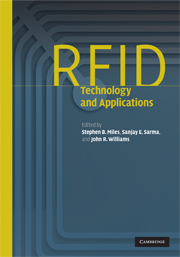Book contents
- Frontmatter
- Contents
- List of contributors
- Preface
- Acknowledgments
- 1 Introduction to RFID history and markets
- 2 RFID technology and its applications
- 3 RFID tag performance optimization: a chip perspective
- 4 Resolution and integration of HF and UHF
- 5 Integrating sensors and actuators into RFID tags
- 6 Performance evaluation of WiFi RFID localization technologies
- 7 Modeling supply chain network traffic
- 8 Deployment considerations for active RFID systems
- 9 RFID in the retail supply chain: issues and opportunities
- 10 Reducing barriers to ID system adoption in the aerospace industry: the aerospace ID technologies program
- 11 The cold chain
- 12 The application of RFID as anti-counterfeiting technique: issues and opportunities
- 13 Closing product information loops with product-embedded information devices: RFID technology and applications, models and metrics
- 14 Moving from RFID to autonomous cooperating logistic processes
- 15 Conclusions
- Appendix – links to RFID technology and applications resources
- Editor biographies
- Index
- References
12 - The application of RFID as anti-counterfeiting technique: issues and opportunities
Published online by Cambridge University Press: 02 November 2009
- Frontmatter
- Contents
- List of contributors
- Preface
- Acknowledgments
- 1 Introduction to RFID history and markets
- 2 RFID technology and its applications
- 3 RFID tag performance optimization: a chip perspective
- 4 Resolution and integration of HF and UHF
- 5 Integrating sensors and actuators into RFID tags
- 6 Performance evaluation of WiFi RFID localization technologies
- 7 Modeling supply chain network traffic
- 8 Deployment considerations for active RFID systems
- 9 RFID in the retail supply chain: issues and opportunities
- 10 Reducing barriers to ID system adoption in the aerospace industry: the aerospace ID technologies program
- 11 The cold chain
- 12 The application of RFID as anti-counterfeiting technique: issues and opportunities
- 13 Closing product information loops with product-embedded information devices: RFID technology and applications, models and metrics
- 14 Moving from RFID to autonomous cooperating logistic processes
- 15 Conclusions
- Appendix – links to RFID technology and applications resources
- Editor biographies
- Index
- References
Summary
In industries including aerospace, pharmaceuticals, and perishables, as covered in the preceding chapters, counterfeit trade has developed into a severe problem. While established security features such as holograms, micro printings, and chemical markers do not seem to efficiently avert trade in illicit imitation products, RFID technology, with its potential to automate product authentications, may become a powerful tool to enhance brand and product protection. The following contribution aims at structuring the requirement definition for such a system by providing a non-formal attack model, and outlines several principal approaches to RFID-based solutions.
Counterfeit trade and implications for affected enterprises
Intangible assets constitute a considerable share of many companies' equity. They are often the result of extensive investments in research and development, careful brand management, and a consistent pledge to deliver high quality and exclusiveness. However, the growth of markets in Asia, where these intangible assets are difficult to protect, the trend in favor of dismantling border controls to ease the flow of international trade, and the increasing interaction of organizations in disparate locations require new measures to protect these assets and safeguard companies from unfair competition. Especially product counterfeiting, the unauthorized manufacturing of articles that mimic certain characteristics of genuine goods and may thus pass off as products of licit companies, has developed into a threat to consumers and brand owners alike.
Counterfeit trade appears to affect a wide range of industries.
- Type
- Chapter
- Information
- RFID Technology and Applications , pp. 157 - 168Publisher: Cambridge University PressPrint publication year: 2008
References
- 1
- Cited by



